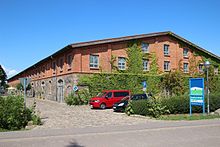Bollewick Barn
The barn in Bollewick near Röbel / Müritz in the Mecklenburg Lake District is the largest field stone barn in Germany.
history
The barn was built in 1881 by Baron Adolph Theodor Wilhelm von Langermann zu Erlenkamp and Spitzkuhn (1805–1889). In 1930 the barn came into the possession of several farmers. It served as a stable, storage and barn, as well as a workshop for craftsmen. Part of the building was also used for residential purposes. In the GDR era (from around 1952) the barn was used as a dairy cattle facility with a stable for 650 cattle.
When the agricultural production cooperative disbanded in 1991 , the municipality was looking for a re-use of the waste contaminated with manure . After the pond had been dredged and over 1000 tons of concrete had been removed, the reconstruction in its original appearance began with funding from the municipality, the state, the Federal Republic of Germany and the European Union.
nature
The foundation walls were built from hewn field stones . Then came a brick structure . The dimensions of the floor plan of the barn are 125 × 34 m.
use
Inside there are rows of shops, offices, a hotel with restaurants and event areas. The barn has meanwhile developed into a cultural attraction in the region. Markets, concerts and theatrical performances that attract national attention also take place there.
Web links
Individual evidence
- ↑ Thomas Hahn: Self-sufficiency instead of rural exodus: Village of the future . In: sueddeutsche.de . ISSN 0174-4917 ( sueddeutsche.de [accessed on August 9, 2016]).
Coordinates: 53 ° 21 ′ 11.4 " N , 12 ° 34 ′ 41" E

